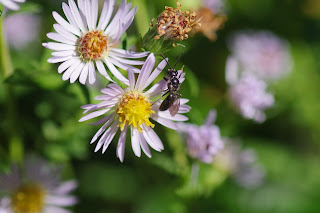I have seen how enthusiastically pollinators flock to nectar sources this time of year:
The major pollen source in my backyard remains the asters at the moment (the chrysanthemum buds are finally showing signs of opening, but not yet). This particular small patch was in the full sun on a somewhat chilly day, and this is where all the insects wanted to be. You should be able to see 4 different species here. There is a 5th on the far side of one of the flowers that you can't see, but I know it was there.
In the several minutes I stood there watching and photographing, many other species flew in. Can you see any?
Here are a couple.
Sometimes they will share harmoniously. Sometimes not. If you look at the highest flower in the picture you can see a tiny bit of the wings of the wasp that was hidden.
Flies are underappreciated pollinators, I think.
The morning glories have a few fans:
Thread-waisted wasp. And notice the fall colors in the background.
You may wonder what difference it makes if pollinators have anything to eat, if they are not pollinating our food sources. The reason you want to feed them now is so that there will be pollinators in the spring–you have to support their life cycle, feed them in the fall, and again in the spring so that when crops are ready to be pollinated, there will be pollinators to do it. Of course, that's only if you don't just see the value in supporting nature for its own sake.
Backyard Bug of the Day:
Dragonfly. I had to magnify this so you could see it. This was in a spot where I could not physically get any closer.
Other Bugs:
Stilt bug
Stinkbug nymph
Looper caterpillar on one of the few remaining goldenrod flowers
Milkweed bugs
Assassin bug nymph
Cocoons. My guess would be wasps, rather than butterflies or moths, but I am no expert.
There were a few grasshoppers around in the rock garden:
Arachnid Appreciation:
.
.
.
.
.
.
.
.
.
.
.
.
The marbled orb weaver did build a new web last night. Tonight was in her bower again.





















No comments:
Post a Comment